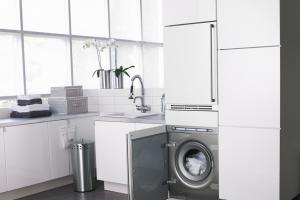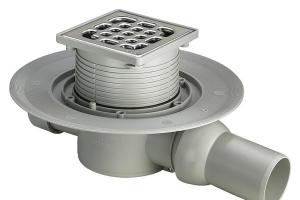Sink above the washing machine: features of installation and installation
A standard bathroom, like a combined bathroom, rarely boasts a lot of free space. The owner of such a room has to puzzle over where and how to place all the necessary plumbing and household appliances.
Due to lack of space, it is often necessary to transfer the latter to other rooms, which causes additional inconvenience. Manufacturers of plumbing fixtures have found a practical solution to this problem.
The main advantage of such a solution is obvious: the possibility of using free space with maximum efficiency. After all, even in the smallest bathroom it is possible to put a washing machine.
In addition, a cabinet with a mirror can be placed above the bowl and thus use every free centimeter. In this case, the design of the room will not suffer.
The sink above the washing machine will not only save space, but also help to organize the space in the bathroom as clearly as possible.
This placement of the washing machine helps to save free space in the bathroom and use it as efficiently as possible.
On sale you can find sinks of various colors and designs that will only decorate the interior of the room.
But one should not think that such a solution has no drawbacks. They exist and there are quite a few of them.
Installing a sink above a washing machine suggests that in the event of a leak, water can cause damage to an electrical appliance and wiring problems. Electric shock is also possible.
- Water retention in the bowl and in the siphon, due to the shape of the shell. It is flat and shallow, and the drain hole is located at the back of the appliance. In such conditions, the water cannot leave completely and you have to remove it yourself with a sponge or soft cloth. Stagnation of fluid contributes to the frequent occurrence of blockages. This is especially true for narrow slit-like drains.
- Difficulties in purchasing accessories. The device is equipped with a special flat siphon, which is quite difficult to find on sale. If the sink is not fully equipped, it is better to refuse the purchase, otherwise it will take a very long time, often to no avail, to look for the necessary parts. The same problems await the owners of failed devices.
- A little discomfort when using the sink. Approaching the bowl, you need to remember that there is a washing machine under it, so standing close to it is not very comfortable. At first, you may have to hit the panel of the car several times until you get into the habit of washing your face at some distance from the sink.
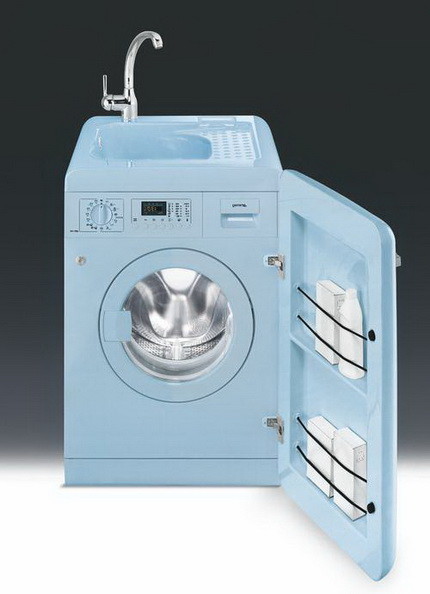
Almost all well-known manufacturers of washing machines produce such sets of equipment. The devices included in their composition are ideally suited for collaboration. In addition, they have a spectacular overall design that will brighten up the bathroom.
An important question: how to choose equipment?
Even an inexperienced plumber understands that a sink installed in a bathroom above a washing machine must be special.
And indeed it is. Few people try to mount standard equipment over an electrical appliance. This is very unsafe and impractical.
Sinks, as well as “washers”, designed to work “in pairs”, differ from traditional counterparts in a number of features. Experts recommend purchasing sets of such equipment, which are produced by almost all leading manufacturers of household appliances.
In such a tandem, the devices are perfectly adapted to work together, in addition, they are also well arranged, which favorably affects their appearance.
If you can't purchase a kit, you will have to buy the equipment separately.
Choosing a washing machine
The best option is to purchase a device specifically designed for installation under the sink. These machines vary in size.
Their depth varies from 43 to 34 cm, and the height cannot be more than 60 cm. It is clear that equipment of this size has a small capacity.
Typically, the maximum load of such models does not exceed 3.5 kg of dry laundry. This is not too much and most often not enough for a large family, so some decide to purchase standard equipment.
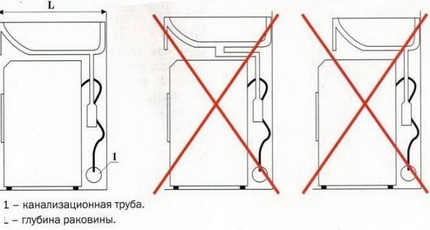
When choosing equipment, you need to clearly determine its size. The diagram shows the options for correct and incorrect installation of devices, which largely depends on the dimensions of the device
Let's start with the height of the device. Theoretically, it can be anything, but in practice it will need to be added to at least 20 cm for the height of the sink and the gap between the planes of the equipment.
As a result, a sink fixed above a 70 cm high machine will be at a level of about 90 cm, and a bowl installed above an 85 cm appliance will rise more than a meter above the floor level.
It will be simply impossible for a child or even a person with small stature to wash over such a sink.
You will have to equip the bathroom with a special bench or install a small step-stand, which is not very convenient.
The second difficulty lies in the correct selection of the depth of the machine. You need to understand that the appliance must be completely placed under the sink.
It is best that the bowl overlaps it slightly, extending like a protective visor over the top panel of the device. In this case, water splashing from the sink will not fall on the washing machine.
At the same time, it must be remembered that it will not work to move the device close to the wall. There should be a gap of about 7-8 cm behind, in which engineering communications will be located.
As practice shows, finding a standard heavy-load washing machine that meets all these requirements is quite difficult.
We select a sink
Bowls designed to be mounted above washing machines are commonly referred to as water lilies.
They got their unusual name because of their small height and characteristic flat shape, reminiscent of the leaves of a plant. But not only an unusual appearance distinguishes devices from standard counterparts.
The drain in such sinks is usually located near the back of the bowl, and not in the center. The hole for the mixer can be anywhere or absent. Water lilies are made from a variety of materials.
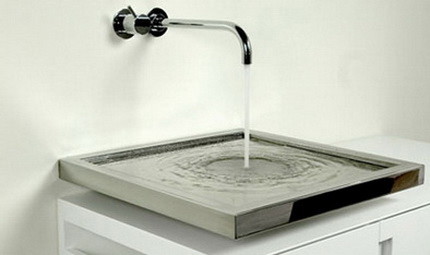
Modern sinks designed to be installed above the washing machine. can have a variety of shapes and be made from various materials
Products made from a relatively new polymer concrete material, which is also called artificial stone, are very good. It is highly resistant to mechanical stress and chemical compositions.
Polymer concrete imitates various types of natural stone so well that visually it is very difficult to distinguish it from natural material. In addition, on sale you can find such sinks made of glass, acrylic, metal and ceramics.
The design of the "water lilies" is very different. They produce bowls of rectangular, oval, square shape with rounded or right angles.
If desired, you can find products of non-standard configuration. The color of plumbing equipment can be any. And yet, when choosing a product, special attention should be paid not to its appearance, but to linear characteristics.
It is optimal that the length of the sink from its outer edge to the wall is greater than the length of the washing machine. The minimum difference is 10 cm. In this case, the machine will be covered from water splashes by a shell protruding above it like a visor.
This is especially true for electrical appliances, in which the control panel is located on the top panel, and not on the front.
In addition, we should not forget about the technological gap between the wall and the washing machine. Even if you plan to build a sewer pipe into the wall, the connecting pipe will remain outside, which will require free space.
Experts advise purchasing sinks with a length of at least 50 cm for narrow machines with a depth of 36-39 cm; for more spacious machines with a depth of 50-51 cm, the bowl should be no shorter than 60 cm.
Another important point is the type of sink drain. It can have a different shape, size and device, which significantly affects the performance properties of the bowl.
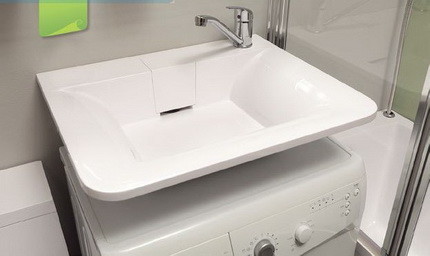
The drain in the form of a gap looks aesthetically pleasing, but quite often clogs
The drain should be located as close as possible to the back wall of the sink, preferably right on it. In some cases, it is placed in a recess under the soap dish at the junction of the side and back walls of the bowl. There are two main forms of plum:
- Round. Assumes the presence of a flat siphon, which is located under the drain hole. The main drawback is the placement of the siphon directly above the electrical appliance, which, if leaked, is fraught with a short circuit and wiring problems. But water quickly leaves through the round holes, and they are less likely to become clogged.
- Slit-like. The main advantage is that the siphon in this case is placed in the back of the bowl, that is, behind the washing machine. Therefore, even with a leak, water should not get on the appliance. The main disadvantage of the system: a narrow drain hole, which often becomes clogged and requires cleaning.
Water lily sinks are sometimes equipped with an overflow system that prevents the bowl from overflowing and water from entering the washing machine.
The drain holes of such a system are usually located, as in standard sinks, on the side and bottom of the bowl. In addition, the drain system can be equipped with plugs, some models are equipped with automation.
With washing machines, in addition to "water lilies", you can try to combine other types of sinks. However, in this case, saving space is unlikely to succeed. The most common options:
- Built-in bowls that are mounted on a table, cabinet or countertop.
- Overhead. It is installed on a horizontal base, for example, the same countertop or cabinet.
Installing a sink above an electrical appliance
The equipment installation technology is quite simple and includes three main stages. Let's take a closer look at each of them.
Fixing the bowl
To attach the water lily sink to the wall, use the brackets that come with it. The master only needs to fix them at the right height and hang the bowl.
Let's get to work:
- We mark the wall. We draw a line corresponding to the top panel of the washing machine. We will make the rest of the marks relative to this feature. We try on the bowl, not forgetting to leave a gap between the sink and the washing machine. Its value depends on the type of siphon. We outline the holes for the fasteners. If the bowl is located close to the bath and it is planned to install a common mixer, we check whether the length of its spout is sufficient.
- We drill holes. We use anchor bolts or dowel fasteners as fasteners.
- Install brackets. We do not completely tighten the bolts yet, leaving small gaps of 5 mm.
- Apply silicone sealant to the back of the sink. The composition is applied in a strip at a distance of 5-10 mm from the edge of the bowl. We carry out a similar procedure with the protrusions of the brackets, where they come into contact with the surface of the sink.
- We install the bowl on the brackets. To do this, we put the shell eyes on the metal hooks and fix it to the wall with dowels or anchor fasteners.
- Fully tighten the bolts securing the brackets.
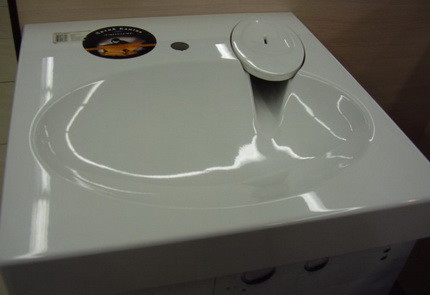
The water lily sink drain is located as close as possible to the back wall of the bowl
We mount the siphon
- We assemble the assembly, guided by the scheme, which the manufacturer must include in the packaging with the product. Do not forget to thoroughly coat all sealing elements and threaded connections with silicone grease. We tighten the thread very carefully, otherwise the plastic parts may not withstand the force and break.
- We find a pipe for connecting a washing machine at the siphon and put a drain hose on it. The resulting connection must be fixed with a clamp with a screw tightening. So we can be sure that the pressure of the water drained from the tank of the washing machine will not break the hose.
- We connect the outlet of the siphon to the sewer. Masters advise to additionally bend the corrugated pipe outlet in the form of a knee and secure it with insulating tape or soft wire. This is necessary to prevent the possible appearance of an unpleasant odor from the sewer, since in the flat siphons that the water lilies are equipped with, due to their design features, the water seal is very often broken.
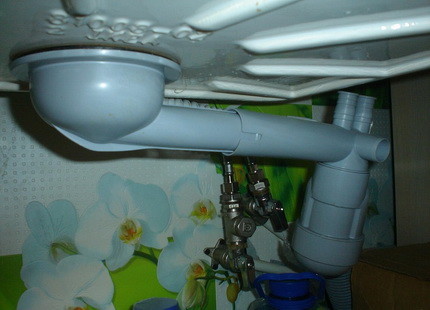
The flat siphon for the sink is equipped with a special pipe for connecting the drain hose from the washing machine
Installing the mixer
The design features of a flat sink suggest the absence of a faucet. The best option for such devices is a mixer mounted on the wall.
The most commonly used model is with a long spout, common for a bathtub and a washbasin. In some cases, a hole is provided in the water lily body for installing a mixer.
It is installed in strict accordance with the manufacturer's instructions after the installation of the siphon is completed and the bowl is finally fixed to the brackets.
In the process of installing the mixer, do not forget about careful sealing. All seals must be lubricated with silicone grease.
Threaded connections are sealed with sanitary tow with paste or fum tape. We tighten the nuts on the mixer hoses very carefully. They are made of rather brittle zinc alloys, excessive force can simply destroy them.
After the installation is completed, we carry out a trial run and carefully inspect all connections for possible leaks.
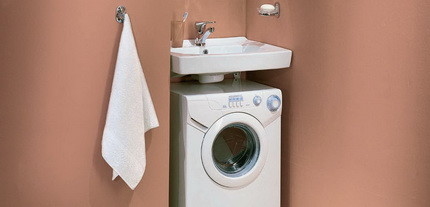
If the "water lily" is equipped with a hole for the mixer, it is installed in strict compliance with all instructions from the manufacturer
A bathroom sink mounted above a washing machine is a practical solution that helps to save and efficiently organize free space.
It is very easy to implement it in your home. You need to choose the right electrical appliance and plumbing equipment, it will be easiest to purchase a special kit. They are offered by many manufacturers. You can install such a tandem yourself.
During installation, it is important to remember the need to ensure electrical safety and perform all work carefully, observing all the requirements of the instructions.

